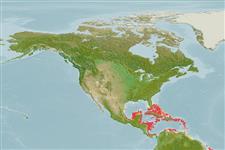Common names from other countries
Issue
Could be a complex of 5 species (Robertson, oral presentation IPFC9, 26 June 2013).
Environment: milieu / climate zone / depth range / distribution range
Ecologia
marinhas associadas(os) a recifes; intervalo de profundidade 8 - 20 m (Ref. 26938). Tropical
Western Atlantic: Cuba (Ref. 26340) and the Bahamas. Also Navassa Island (Ref. 50108).
Tamanho / Peso / Idade
Maturity: Lm ? range ? - ? cm
Max length : 3.4 cm TL macho/indeterminado; (Ref. 5521)
Espinhos dorsais (total) : 19 - 20; Raios dorsais (total) : 7 - 9; Espinhos anais: 2; Raios anais : 16 - 18; Vértebras: 31 - 33.
Inhabits coral reefs (Ref. 5521).
Ciclo de vida ou comportamento de acasalamento
Maturities | Reprodução | Spawnings | Egg(s) | Fecundities | Larvas
Böhlke, J.E. and C.C.G. Chaplin, 1993. Fishes of the Bahamas and adjacent tropical waters. 2nd edition. University of Texas Press, Austin. (Ref. 5521)
Status na Lista Vermelha da UICN (Ref. 130435)
CITES (Ref. 128078)
Not Evaluated
Ameaça para os humanos
Harmless
Uso pelos humanos
Ferramentas
Relatórios especiais
Baixar XML
Fontes da internet
Estimates based on models
Preferred temperature (Ref.
115969): 26.3 - 28.2, mean 27.5 (based on 571 cells).
Índice de diversidade filogenética (Ref.
82804): PD
50 = 0.5000 [Uniqueness, from 0.5 = low to 2.0 = high].
Bayesian length-weight: a=0.00490 (0.00196 - 0.01224), b=3.09 (2.87 - 3.31), in cm Total Length, based on LWR estimates for this (Sub)family-body shape (Ref.
93245).
Nível Trófico (Ref.
69278): 3.3 ±0.4 se; based on size and trophs of closest relatives
Fishing Vulnerability (Ref.
59153): Low vulnerability (10 of 100).
